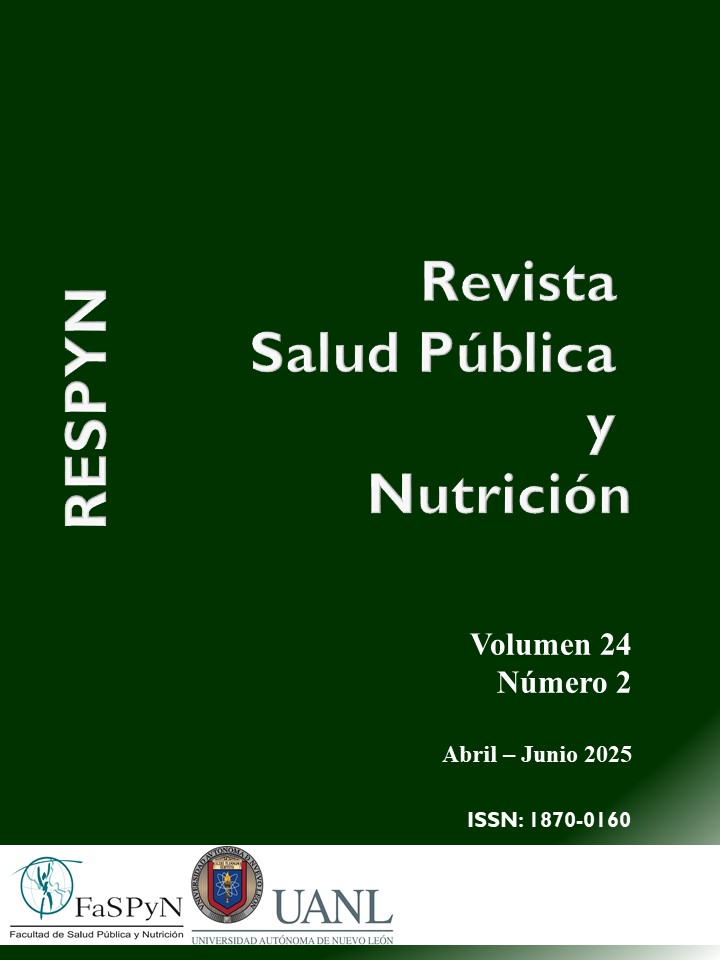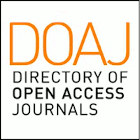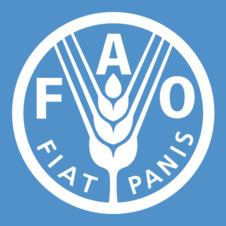Association between grip strength, comorbidities, and anthropometric indicators in older adults attending nutritional consultations
DOI:
https://doi.org/10.29105/respyn24.2-847Keywords:
hand strength, aged, skeletal muscleAbstract
Introduction: Human aging is marked by a decline in biological and metabolic functions, impacting overall health. Malnutrition, common in older adults, is linked to muscle mass loss and chronic diseases. Grip strength is an effective indicator of muscle function and nutritional status, especially in older adults. Objective: To describe the relationship between grip strength, the presence of comorbidities, and anthropometric indicators in older adults attending nutritional consultations in San Luis Potosí, Mexico. Material and method: Cross-sectional descriptive study with 120 older adults. Sociodemographic, anthropometric, and dietary data were collected. Grip strength was measured using a dynamometer, and statistical analyses were performed with SPSS. Results: Grip strength correlated positively with muscle mass, weight, height, and calf circumference, and negatively with body fat percentage. A weak correlation was observed with comorbidities. Conclusion: Grip strength is a good indicator of functional and nutritional status in older adults. It is associated with muscle mass and other anthropometric factors, suggesting its utility in assessing frailty and sarcopenia risks. Further exploration of its clinical application is recommended.
Downloads
References
Agüero, S. D., Fuentes, J. F., & Leiva, A. V. (2017). Dinamometría, masa muscular y masa grasa braquial en adultos mayores autovalentes. Revista Española de Nutrición Comunitaria, 23(4), 1–7. https://www.renc.es/imagenes/auxiliar/files/RENC_2017_4_3._Duran_Aguero.pdf
Bohannon, R. W. (2019). Grip strength: An indispensable biomarker for older adults. Clinical Interventions in Aging, 14, 1681–1691. https://doi.org/10.2147/CIA.S194543 DOI: https://doi.org/10.2147/CIA.S194543
Bustos-Viviescas, B., Acevedo-Mindiola, A., & Lozano-Zapata, R. (2021). Grasa corporal y fuerza prensil de la mano: Asociación por edades y sexos en sujetos aparentemente sanos. Revista Cubana de Investigaciones Biomédicas, 42(1). https://revibiomedica.sld.cu/index.php/ibi/article/view/1264
Cederholm, T. (2014, March). Overlaps between frailty and sarcopenia definitions. In Frailty: Pathophysiology, phenotype, and patient care: 83rd Nestlé Nutrition Institute Workshop, Barcelona (Vol. 83, p. 0). https://doi.org/10.1159/000382063 DOI: https://doi.org/10.1159/000382063
Collado-Carrera, C., Priego-Álvarez, H. R., Magaña-Castillo, M., González-Javier, F. P. (2024). Patrones dietéticos en el aumento de masa muscular en adultos mayores: Una revisión sistemática. Revista Salud Pública y Nutrición, 23(3), 21–29. https://doi.org/10.29105/respyn23.3-800 DOI: https://doi.org/10.29105/respyn23.3-800
Concha-Cisternas, Y., Petermann-Rocha, F., Castro-Piñero, J., Parra, S., Albala, C., Wyngard, V. V. D., ... & Celis-Morales, C. (2022). Fuerza de prensión manual: Un sencillo, pero fuerte predictor de salud en población adulta y personas mayores. Revista Médica de Chile, 150(8), 1075–1086. https://dx.doi.org/10.4067/S0034-98872022000801075 DOI: https://doi.org/10.4067/S0034-98872022000801075
Cruz-Jentoft, A. J., Bahat, G., Bauer, J., Boirie, Y., Bruyère, O., Cederholm, T., ... & Zamboni, M. (2019). Sarcopenia: Revised European consensus on definition and diagnosis. Age and Ageing, 48(1), 16–31. https://doi.org/10.1093/ageing/afy169 DOI: https://doi.org/10.1093/ageing/afz046
De la Garza Villarreal, A. (2024). Factores asociados a la disminución en la fuerza de prensión en adultos mayores con fractura de cadera (Tesis de grado, Especialista en Geriatría Clínica). Universidad Autónoma de Nuevo León, Facultad de Medicina. Recuperado de http://eprints.uanl.mx/28806/7/28806.pdf
Farías-Valenzuela, C., Pérez-Luco, C., Ramírez-Campillo, R., Álvarez, C., & Castro-Sepúlveda, M. (2018). El consumo pico de oxígeno es mejor predictor de riesgo cardiovascular que la fuerza prensil en mujeres chilenas adultas mayores. Revista Española de Geriatría y Gerontología, 53(3), 141–144. https://doi.org/10.1016/j.regg.2017.09.003 DOI: https://doi.org/10.1016/j.regg.2017.09.003
García Almeida, J. M., García García, C., Bellido Castañeda, V., & Bellido Guerrero, D. (2018). Nuevo enfoque de la nutrición: Valoración del estado nutricional del paciente: Función y composición corporal. Nutrición Hospitalaria, 35(SPE3), 1–14. https://dx.doi.org/10.20960/nh.2027 DOI: https://doi.org/10.20960/nh.2027
Hernández-Martínez, J. G., Anguita-Vera, C., Asenjo-Flores, P., Solis-Millaguin, M., & Asenjo-Paredes, C. (2019). Niveles de fuerza de agarre de mano y composición corporal de mujeres mayores chilenas. Lecturas: Educación Física y Deportes, 24(256), 46–58. https://efdeportes.com/efdeportes/index.php/EFDeportes/article/view/951
López-Cruz, L. V., Navia-Cardona, L. I., Ortiz-Lamprea, V., Carvajal-Tello, N., Segura-Ordoñez, A., & Ávila-Valencia, J. C. (2022). Relación de la fuerza manual prensil con variables sociodemográficas y antropométricas en pacientes con insuficiencia cardíaca crónica. Cuestiones de Fisioterapia, 51(2), 112–121. https://enfispo.es/servlet/articulo?codigo=8452853
Marín, F. A. Y., & Jaeger, A. S. (2019). Estado nutricional, masa muscular, fuerza y riesgo cardiometabólico en adultos mayores no institucionalizados. Salus, 23(2), 8–17. https://www.redalyc.org/journal/3759/375967530003/html/
Marucci, M. F. N., Roediger, M. A., Dourado, D. A. Q. S., & Bueno, D. R. (2019). Comparison of nutritional status and dietary intake self-reported by elderly people of different birth cohorts (1936 to 1940 and 1946 to 1950): Health, Wellbeing and Aging (SABE) Study. Comparação do estado nutricional e da ingestão alimentar referida por idosos de diferentes coortes de nascimento (1936 a 1940 e 1946 a 1950): Estudo Saúde, Bem-Estar e Envelhecimento (SABE). Revista brasileira de epidemiologia = Brazilian journal of epidemiology, 21Suppl 02(Suppl 02), e180015. https://doi.org/10.1590/1980-549720180015.supl.2 DOI: https://doi.org/10.1590/1980-549720180015.supl.2
Norton, K. I. (2018). Standards for anthropometry assessment. In Kinanthropometry and exercise physiology (pp. 68-137). Routledge. https://doi.org/10.4324/9781315385662 DOI: https://doi.org/10.4324/9781315385662-4
Palos Lucio, A. G., Ríos Lugo, M. J., Victoria Campos, C. I., González Acevedo, O., Acebo Martínez, M. L., & Hernández Gaytán, D. (2020). Fuerza de agarre como predictor de composición corporal en estudiantes universitarias. Revista Chilena de Nutrición, 47(4), 604–611. https://doi.org/10.4067/S0717-75182020000400604 DOI: https://doi.org/10.4067/S0717-75182020000400604
Peralta Vargas, C. E., Falvy Bockos, I., & Valdivia Alcalde, C. (2022). Relación entre fragilidad en adultos mayores y fuerza de prensión disminuida. Horizonte Médico (Lima), 22(2). https://doi.org/10.24265/horizmed.2022.v22n2.07 DOI: https://doi.org/10.24265/horizmed.2022.v22n2.07
Ramírez Berrios, L., Gutiérrez Velasco, E., Runzer Colmenares, F., Espinoza Gutiérrez, G., Chambergo Michilot, D., Falvy Bockos, I., & Vidal Neira, L. (2023). Correlación entre el porcentaje de grasa corporal y el índice de masa corporal en adultos mayores: Rol del sexo y edad. Revista Española de Nutrición Comunitaria, 1–6. https://www.renc.es/imagenes/auxiliar/files/RENC-D-22-0043._Manuscrito_final.pdf
Sieber, C. C. (2017). Frailty—from concept to clinical practice. Experimental Gerontology, 87, 160–167. https://doi.org/10.1016/j.exger.2016.05.004 DOI: https://doi.org/10.1016/j.exger.2016.05.004
Szlejf, C., Parra-Rodríguez, L., & Rosas-Carrasco, O. (2017). Osteosarcopenic obesity: Prevalence and relation with frailty and physical performance in middle-aged and older women. Journal of the American Medical Directors Association, 18(8), 733.e1–733.e5. https://doi.org/10.1016/j.jamda.2017.02.023 DOI: https://doi.org/10.1016/j.jamda.2017.02.023
Toasa Moya, J. M., Latta Sánchez, M. A., & Reales Chacón, L. J. (2024). Fuerza de agarre y su relación con el riesgo de caída en el adulto mayor: Revisión sistemática de la literatura. Serie Científica de la Universidad de las Ciencias Informáticas, 17(5), 40–54. http://scielo.sld.cu/pdf/sc/v17n5/2306-2495-sc-17-05-40.pdf
Tomkinson, G. R., Lang, J. J., Rubín, L., McGrath, R., Gower, B., Boyle, T., ... & Leong, D. P. (2024). International norms for adult handgrip strength: A systematic review of data on 2.4 million adults aged 20 to 100+ years from 69 countries and regions. Journal of Sport and Health Science, 101014. https://doi.org/10.1016/j.jshs.2024.101014 DOI: https://doi.org/10.1016/j.jshs.2024.101014
Triana-Reina, H. R., Ortiz-Pacheco, L. E., & Ramírez-Vélez, R. (2022). Menores valores de fuerza de prensión manual se asocian a incremento de los niveles de adiposidad y exceso de peso: Un estudio transversal. Nutrición Hospitalaria, 39(4), 752–759. https://dx.doi.org/10.20960/nh.04004 DOI: https://doi.org/10.20960/nh.04004
Vázquez-Alonso, M. F., Díaz-López, J. J., Lázaro-Huerta, M., & Guamán-González, M. O. (2021). Medición de la fuerza de prensión y de las pinzas de la mano en pacientes sanos. Acta Ortopédica Mexicana, 35(1), 56–60. http://www.scielo.org.mx/scielo.php?script=sci_arttext&pid=S2306-41022021000100056 DOI: https://doi.org/10.35366/100932
White, J. V., Guenter, P., Jensen, G., Malone, A., Schofield, M., Academy Malnutrition Work Group, A.S.P.E.N. Malnutrition Task Force, & A.S.P.E.N. Board of Directors. (2012). Consensus statement: Academy of Nutrition and Dietetics and American Society for Parenteral and Enteral Nutrition: Characteristics recommended for the identification and documentation of adult malnutrition (undernutrition). JPEN. Journal of Parenteral and Enteral Nutrition, 36(3), 275–283. https://doi.org/10.1177/0148607112440285 DOI: https://doi.org/10.1177/0148607112440285
World Health Organization. (2024). Envejecimiento y salud. Organización Mundial de la Salud. https://www.who.int/es/news-room/fact-sheets/detail/ageing-and-health
World Health Organization. (2024). Malnutrición. https://www.who.int/es/news-room/questions-and-answers/item/malnutrition
Downloads
Published
How to Cite
Issue
Section
License
Copyright (c) 2025 Elisa Fernanda Alba Ramírez, Mónica Lucía Acebo Martínez, Adriana Berenice Rousset Román , Aida Karina Arriaga Sánchez

This work is licensed under a Creative Commons Attribution 4.0 International License.
The rights of the work belong to the author or authors, however, by sending it for publication in the Public Health and Nutrition Magazine of the Faculty of Public Health and Nutrition of the Autonomous University of Nuevo León, they grant the right for its first publication in between electronic, and possibly, in print to the Public Health and Nutrition Magazine. The license used is the Creative Commons attribution, which allows third parties to use what is published whenever the authorship of the work is mentioned and the first publication that is in the Public Health and Nutrition Magazine. Likewise, the author or authors will take into account that it will not be allowed to send the publication to any other journal, regardless of the format. The authors will be able to make other independent and additional contractual agreements for the non-exclusive distribution of the version of the article published in the Public Health and Nutrition Magazine (e.g., institutional repository or publication in a book) provided they clearly state that The work was published for the first time in the Public Health Magazine, Magazine of the Faculty of Public Health and Nutrition of the Autonomous University of Nuevo León.














